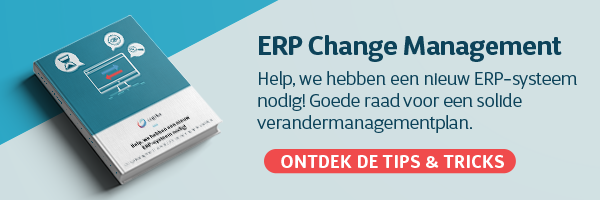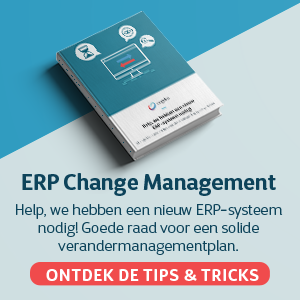Even when you have joined forces with the most experienced, flexible and empathetic – add other qualities as desired – ERP partner, there’s still a lot of work to be done for a major project. Your project team will get the lion’s share of the work. You will need a perfectly coordinated team to work with, so first you must assemble it meticulously.
Putting your dream team together takes more than just bringing together the right people. You may already have an idea of who you want to work with, but the timing of your selection is also crucial, as are your selection criteria. You will also need to pay attention to your team’s mandate – how much freedom they need to operate effectively and how much availability they will have. ERP projects can stand or fall by the selection of the right people with adequate availability.
When to make your selection?
Logically, you need to have an idea of the start date of your ERP before you can finalize the selection of your team. First off, start with the selection process, as this is the best way to involve all team members. You get to see how they will work together, and they can give you their input. This is a nice way to generate broad support for the project. Then, once the team has been finalized, you can pay attention to freeing up their schedules. This is the time to consider taking on additional staff – either temporarily or permanently.
Having completed these important steps, you will now be in a position to meet with potential partners, and you can present them with your team. A good partner will help you by critically assessing your team, suggesting improvements if appropriate, and for you, this can say a lot about your partner’s expertise. They need to be able to offer you constructive input if they think your team needs any adjustments.
Who do you select?
The size of your team will depend entirely on the scope of your project. The following is a simple rule-of-thumb guideline for your selection process that may help you think about this:
- Project manager (PM): the PM is responsible for the successful implementation of the project from start to end, in accordance with the specification that has been agreed between your partner, let’s say Cegeka, and you. The PM will be responsible for realizing the project within the scope, budget, timing and quality agreements.
- IT Team: the IT team will focus on nuts-and-bolts IT activities such as data migration, security set-up, adding new users and the modification of documents and reports.
- Business Process owners: the BPOs will determine what requirements and planned processes have to be supported by the solution in the domains for which they are responsible.
- Key users: the key user will test and validate the business processes that are designed for the solution. They act as a single point of contact during the implementation of the project for the processes and domains assigned to them, and ultimately, they will train other users.
- Test Manager: the test manager will supervise the day-to-day management and follow-up of all the test activities. They are responsible for the testing strategy and for making sure that it is robust.
- Change Manager: a change manager plays a crucial role in the entire programme in facilitating the adoption of the solution and the ‘close to standard’ principle.
NB: the above are roles; an individual may fulfil multiple roles, depending on the project and the size of your team.
Above this project team you will have a steering committee. They will monitor the timing, the budget and any changes to the scope. This team should include your PM, chief information officer (or change manager) and a delegate from management, usually the CEO or chief financial officer. You will also need to include a key person from your ERP partner and a management team delegate who can express the high-level vision of the partner.
In larger projects, often international ones, you will also appoint a programme manager, who will make sure that all sub-projects are properly coordinated. You will need to appoint both global and local process owners and key users. Global roles will work for harmonization and interact with their local counterparts. Lastly, there will be an architecture and change board that will ensure the global ERP solution that is to be rolled out has consistency and is maintained across all countries and entities.
How do you select them and what will their mandate be?
Some roles in the project team speak for themselves, as outlined above. However, selecting process owners and key users can be considerably more difficult. As these staff will represent an entire department, they need to have a clear conception of the business pain points and, of course, must display leadership at the same time. With process owners, that goes further still: they must be well aware of the objectives, be able to translate these for the departments and also be able to make radical decisions. Where conflicts of interest arise, the process owner needs to be able to effectively apply the ERP objectives.
In both cases, experienced key figures in your organization must be involved. You cannot completely free up their time at the drop of a hat. This is why you need to assemble your team at an early stage in the ERP process. Then, along with your HR department, you can see how their day-to-day tasks can be reassigned.
Conclusion?
Your ERP partner will do a lot, but they cannot do everything. The most important factor for success remains the selection of the right people. Here is a quick tip: as soon as you have made your selection, ask your people how much time they think they will need for all their ERP tasks. You can then compare these timings with your ERP partner’s estimate. This will give you valuable insights and will make sure that there are no aspects of their roles and responsibilities that you have overlooked.
Your team will not be living in an ivory tower during the project. Remember, communication is key, and part of your team’s task will be to gradually ‘massage’ the new solution in to the rest of the organization. To help you deal best with the process of change, we have created this free e-book, ‘ERP Change Management’. Here you will read interesting tips and tricks that will help you to quickly make allies of your staff and your new system.



